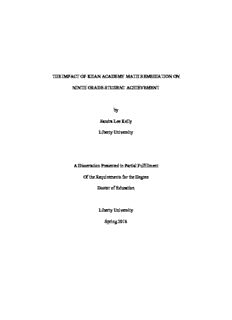
The Impact of Khan Academy Math Remediation on Ninth Grade Student Achievement PDF
Preview The Impact of Khan Academy Math Remediation on Ninth Grade Student Achievement
THE IMPACT OF KHAN ACADEMY MATH REMEDIATION ON NINTH GRADE STUDENT ACHIEVEMENT by Sandra Lee Kelly Liberty University A Dissertation Presented in Partial Fulfillment Of the Requirements for the Degree Doctor of Education Liberty University Spring 2018 2 THE IMPACT OF KHAN ACADEMY MATH REMEDIATION ON NINTH GRADE STUDENT ACHIEVEMENT by Sandra Lee Kelly A Dissertation Presented in Partial Fulfillment Of the Requirements for the Degree Doctor of Education Liberty University, Lynchburg, VA 2018 APPROVED BY: Heidi Hunt, Ed.D., Committee Chair Scott B. Watson, Ph.D., Committee Member Gary Newberry, Ph.D., Committee Member 3 ABSTRACT The purpose of this quasi-experimental study was to determine if using Khan Academy as math remediation for fifteen minutes per day during a ninth grade Math I class would significantly affect student math achievement as measured by the North Carolina READY Math I End-of- Course Assessment. This quantitative study conducted at two rural high schools in West Virginia used remediation theory to make a comparison against a control population with the independent variable being grade level instruction only or grade level instruction plus math remediation using Khan Academy. The participants in the study included 131 ninth grade high school students taking a Math I class in a traditional classroom setting between October 2016 and May of 2017. The researcher collected data from students’ pretest and posttest scores on the North Carolina READY Math I End-of-Course Assessment. The original intent was to use analysis of covariance (ANCOVA) to reduce the effects of any initial group differences. However, the data failed to pass the assumptions necessary for ANCOVA or t-test. So, a nonparametric test, Mann-Whitney U, was used in the analysis. There was no significant difference in the posttest scores of ninth grade Math I students receiving regular instruction only and those receiving regular instruction along with Khan Academy for math remediation. Suggestions for further research are included. Keywords: mathematics, remediation, achievement, college-ready, career-ready, prerequisite, foundational 4 Dedication After graduating with my master’s degree in May of 2008, I asked my mother if she thought I should one day pursue a doctoral degree. After all, I said I would most likely be 50 years old or even older before completing it. Her response was typical of such a wise person. She said, “Sandy, you’ll be 50 whether you get your doctorate or not, you might as well be 50 with a doctorate.” This work is dedicated to my precious mother, Betty Arbaugh, who went to be with the Lord November 5th, 2008. I love you Mom, and I’ll see you again one day. 5 Acknowledgments First, I thank my God for being with me and guiding me throughout this endeavor. I was blessed with wonderful parents who valued education and always supported me. I thank my father, Earl Arbaugh, a teacher, who passed down the desire to educate another generation. I thank my mother, Betty Arbaugh, who always was and still is my greatest cheerleader. I thank my husband, David Simmons, for his patience and support through it all. I am so grateful for the two children that the Lord blessed me with. My son, Jacob, and my daughter, Jessie, are my inspiration and a driving force in this achievement. I am forever grateful for all of my family and friends who have supported me with their prayers and words of encouragement. Many thanks to my chair, Dr. Hunt, for reading, editing, and advising me along the way. Thanks also to Dr. Watson for his patience, guidance, and much assistance throughout the analysis of the data. 6 Table of Contents ABSTRACT.....................................................................................................................................3 Dedication........................................................................................................................................4 Acknowledgments............................................................................................................................5 List of Tables...................................................................................................................................9 List of Figures................................................................................................................................10 List of Abbreviations.....................................................................................................................11 CHAPTER ONE: INTRODUCTION...........................................................................................12 Background........................................................................................................................12 Problem Statement.............................................................................................................17 Purpose Statement..............................................................................................................19 Significance of the Study...................................................................................................20 Research Question.............................................................................................................21 Definitions.........................................................................................................................21 CHAPTER TWO: LITERATURE REVIEW...............................................................................23 Overview............................................................................................................................23 Remediation Theory...........................................................................................................24 Foundational Math Skills...................................................................................................27 Cognitive Science..............................................................................................................30 Prior Knowledge................................................................................................................34 Online Resources...............................................................................................................37 Khan Academy...................................................................................................................41 Discussions and Conclusions.............................................................................................52 7 CHAPTER THREE: METHODS.................................................................................................55 Design................................................................................................................................55 Research Question.............................................................................................................55 Hypothesis..........................................................................................................................55 Participants and Setting......................................................................................................56 Instrumentation..................................................................................................................57 Procedures..........................................................................................................................61 Data Analysis.....................................................................................................................64 CHAPTER FOUR: FINDINGS....................................................................................................67 Overview............................................................................................................................67 Research Question.............................................................................................................68 Null Hypothesis.................................................................................................................68 Descriptive Statistics..........................................................................................................68 Results................................................................................................................................73 CHAPTER FIVE: CONCLUSIONS.............................................................................................74 Discussion..........................................................................................................................74 Additional Analysis...........................................................................................................74 Implications........................................................................................................................77 Limitations.........................................................................................................................78 Recommendations for Future Research ............................................................................80 REFERENCES..............................................................................................................................82 APPENDIX A: REQUEST TO CONDUCT RESEARCH...........................................................92 APPENDIX B: TEACHER INTRODUCTION TO STUDY........................................................95 8 APPENDIX C: KHAN ACADEMY TEACHER PRESENTATION...........................................97 APPENDIX D: PERMISSION FROM NC PUBLIC SCHOOLS...............................................102 APPENDIX E: COMMON CORE STANDARDS MAPPING BY STATE..............................103 APPENDIX F: NC MATH I RELEASED FORM 2012-2013 ANSWER KEY........................104 APPENDIX G: UNMAPPED MATH I COMMON CORE STANDARDS..............................108 APPENDIX H: MATH I PACING GUIDE................................................................................109 APPENDIX I: STUDENT KHAN ACADEMY TRAINING....................................................118 9 List of Tables Table 3.1: EOC Math I Reliabilities..............................................................................................57 Table 3.2: NCDPI Validity Evidence for Math I Assessments.....................................................58 Table 3.3: Unmapped Test Items...................................................................................................60 Table 3.4: Distribution of Sample..................................................................................................65 Table 4.1: Descriptive Statistics....................................................................................................69 Table 4.2: Khan Academy Mission One Completion Levels........................................................70 Table 4.3: Experiment Group Khan Academy Mission Treatment Levels...................................72 10 List of Figures Figure 1: Behaviorism Remediation Flow Chart...........................................................................25 Figure 2: Khan Academy Mission 1 Participation Bar Chart........................................................71 Figure 3: Control Group (1) and Experiment Group Subgroups (2-5) Posttest Means.................73 Figure 4: Mann-Whitney U Posttest Score Distributions .............................................................73
Description: